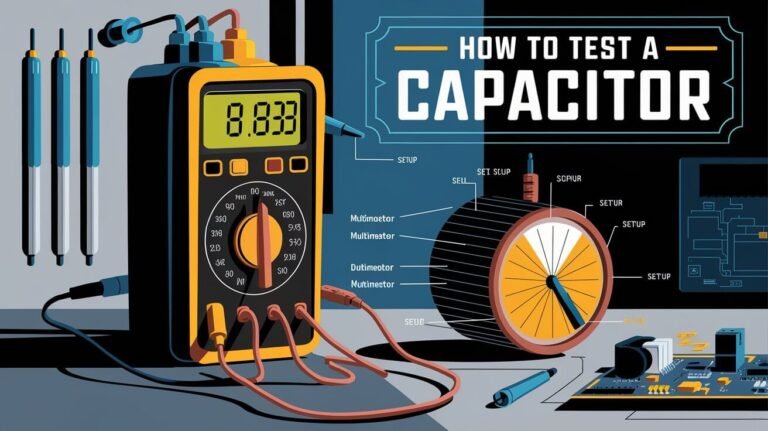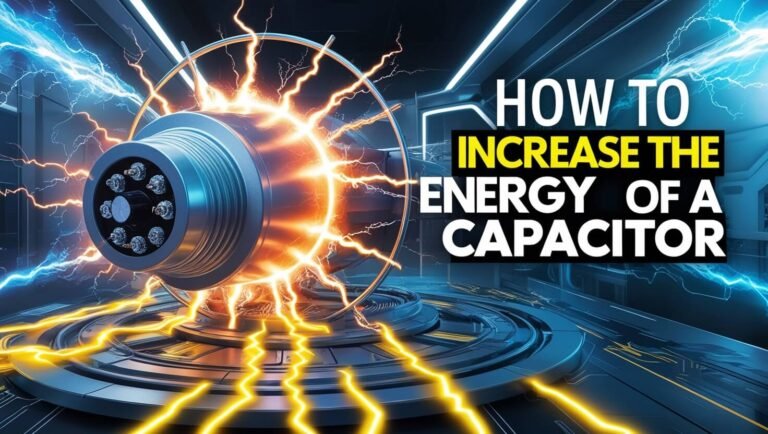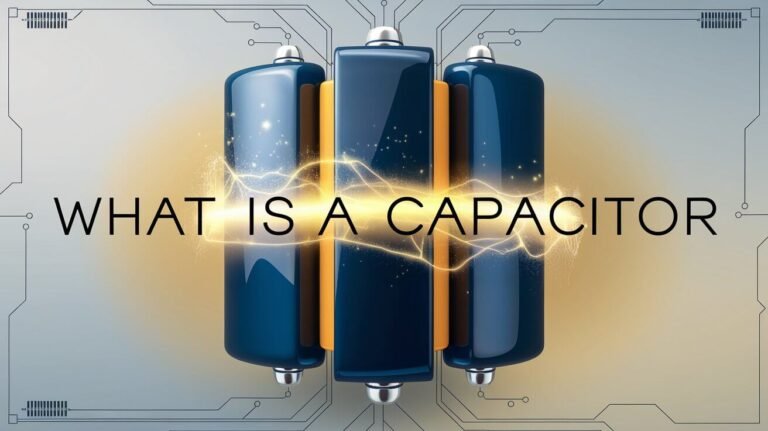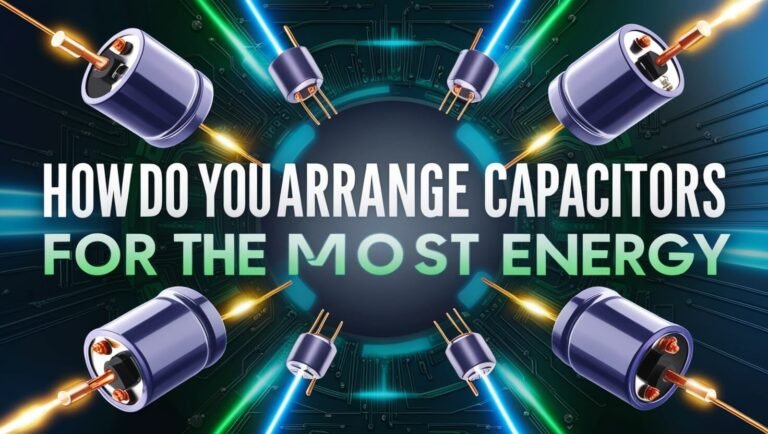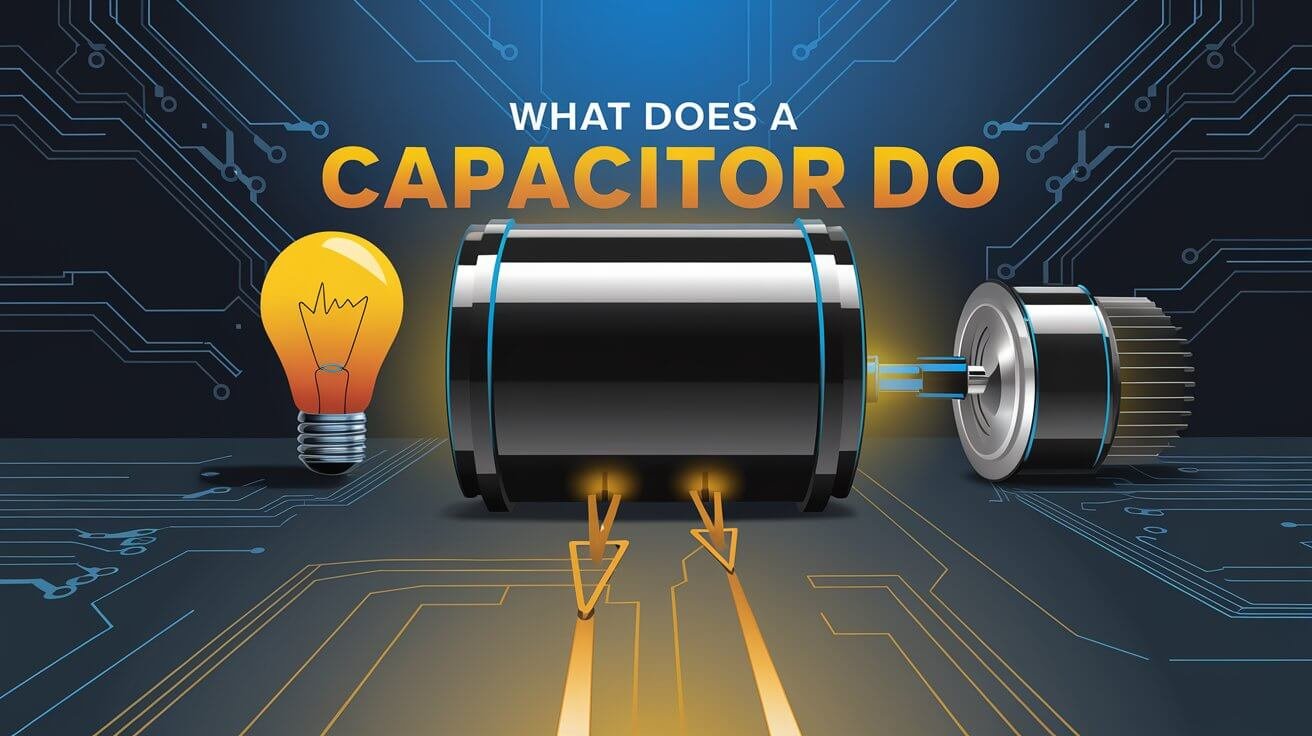
A capacitor is a key part of electronic circuits. It stores and releases electrical energy. This happens because it holds electric charges on two surfaces that are close but not touching.
This makes capacitors important in many devices. They act like tiny batteries but work differently. Their ability to store and release energy is why they’re so important today.
Capacitors have been around for over 270 years. They’ve evolved into many types, each with its own use. Knowing how they store energy is key to making good electronic circuits.
As we look into capacitors, we’ll see how they work and why they’re vital. We’ll learn about their role in modern electronics. This will show us why storing electrical energy is so important.
Basic Function of Capacitors in Electronics
Capacitors are key in electronic circuits. They store energy as an electrical field. This is like filling a water tank, where the water level shows the charge stored.
When powered, the capacitor’s plates hold opposite charges. This makes them great for storing charge efficiently.
Energy Storage Mechanisms
A capacitor stores energy by separating charges. When a voltage is applied, the electric field pushes charges apart. This creates an electric field, essential for how capacitors work.
Charge Distribution Process
The charge distribution in a capacitor is important. The dielectric material between the plates helps distribute charge evenly. This is why capacitors can store charge.
The charge storage ability of a capacitor is measured in farads. One farad can store one coulomb of charge at 1 volt.
Core Operating Principles
The core of a capacitor’s operation involves the electrical field, charge storage, and the dielectric material. Knowing these principles is key for designing and using capacitors. It helps engineers and designers make better electronic systems.
Physical Components of a Capacitor
A capacitor has two conductive parts, like metallic plates, and a dielectric material in between. These plates are made of materials like copper or aluminum. They store electrical charge. The dielectric material, which can be ceramic, plastic, or air, is key to the capacitor’s performance.
The type of dielectric material used is very important. It impacts the capacitor’s ability to hold charge, its voltage limit, and how much current leaks. For instance, ceramic capacitors are very stable and leak little current. Film capacitors, on the other hand, handle high voltages and frequencies well.
Here are some key points about capacitor plates and dielectric materials:
- Capacitor plates: made of conductive materials, such as copper or aluminum
- Dielectric materials: made of ceramic, plastic film, or air
- Capacitance: affected by the area of the plates, the distance between the plates, and the dielectric material used
| Dielectric Material | Capacitance | Voltage Rating |
|---|---|---|
| Ceramic | High | Low |
| Plastic Film | Medium | High |
| Air | Low | Low |
The parts of a capacitor, like the plates and dielectric, are vital. They decide how well the capacitor works and what it’s used for. Knowing about these parts helps designers pick the right capacitor for their projects.
Types of Capacitors and Their Uses
Capacitors are key in electronic devices. They come in different types, each with its own use. Ceramic, electrolytic, film, and supercapacitors are the main types. Ceramic capacitors are great for high-frequency use. Electrolytic capacitors, on the other hand, are used in power supplies because of their high capacitance.
Ceramic capacitors are divided into Class 1 and Class 2. Class 1 is best for stable, low-loss circuits. Class 2 is good for applications needing high volumetric efficiency, but with less stability.
Characteristics of Different Capacitor Types
- Film capacitors have a voltage range of 50 V to 2 kV. They are stable in analog circuits.
- Electrolytic capacitors use materials like aluminum and tantalum. They’re used in power supplies.
- Supercapacitors store a lot of energy quickly. They’re used where high power density is needed.
Knowing about different capacitors is key for choosing the right one. By understanding their characteristics and uses, designers can make sure their devices work well.
| Capacitor Type | Characteristics | Applications |
|---|---|---|
| Ceramic Capacitors | High stability, low losses | Resonant circuit applications, high-frequency applications |
| Electrolytic Capacitors | High capacitance values, polarized | Power supplies, filtering, coupling |
| Film Capacitors | Stable, low dissipation factor | Analog circuits, filtering, coupling |
| Supercapacitors | High power density, fast charging | Energy storage, power backup, regenerative braking |
Power Supply Applications
Capacitors are key in power supply systems. They act as an energy buffer to smooth out voltage changes. This is like how a car’s shock absorber works, making the ride smoother. In power supplies, they keep the voltage stable, which is vital for electronic devices to work right.
Capacitors are great at regulating voltage. They store and release energy as needed. This ensures the power supply’s output voltage stays safe and stable. This is critical for avoiding damage to sensitive electronic parts.
Many household items use capacitors in their power supplies. These include:
- Televisions and computers, which need stable power to work well
- Audio gear, like amplifiers and speakers, for high-quality sound
- Medical devices, such as defibrillators and ultrasound machines, for safe and effective use
Capacitors also help with power smoothing. This is important for reducing electrical noise and protecting sensitive parts. They act as energy buffers, absorbing and releasing energy as needed. This helps keep the power supply stable and prevents voltage changes.
Circuit Protection and Stability
Circuit protection is key to keep electronic circuits safe from voltage spikes and noise. Capacitors are vital in this role, ensuring voltage stability and suppressing surges. They act as a buffer, absorbing extra energy and releasing it when needed, to keep the voltage stable.
Capacitors also help in filtering out unwanted electrical noise. This noise can cause malfunctions or damage. By combining capacitors with other parts like resistors and inductors, we can create filters. These filters control frequency and block unwanted signals.
Some common ways to protect and stabilize circuits include:
- Using capacitors to absorb voltage spikes and suppress surges
- Implementing noise filtering circuits to reduce electrical interference
- Designing circuits with voltage stability in mind, using components that can handle voltage fluctuations
Capacitors provide voltage stability, surge suppression, and noise filtering. By understanding how capacitors work and using them wisely, designers can make electronic circuits that are strong and reliable.
| Component | Function | Benefits |
|---|---|---|
| Capacitor | Voltage stability, surge suppression, noise filtering | Prevents damage from voltage spikes, reduces electrical interference |
| Resistor | Voltage division, current limiting | Helps to regulate voltage, prevents excessive current flow |
| Inductor | Frequency filtering, energy storage | Helps to block unwanted signals, stores energy for later use |
Radio Frequency and Signal Processing
Capacitors are key in radio frequency (RF) circuits, like tuning and signal processing. RF circuits work at high frequencies, including the Microwave and mmWave bands. They are used in RF power amplifiers, cellular base stations, and wireless LAN.
In RF circuits, capacitors filter signals. They let certain frequencies pass through while blocking others. This is important in GPS, keyless entry systems, and Bluetooth. Capacitors with low ESR and high Q are best for RF work.
Some main uses of capacitors in RF circuits include:
- Signal coupling and decoupling
- Tuning and impedance matching
- Filtering and noise reduction
- Creating low-pass, high-pass, band-pass, and band-stop filters
KEMET’s HiQ CBR RF Capacitor Series is designed for high performance. It has a copper electrode BME system for ultra-low ESR, high Q, and high SRF. It works well from 1 MHz to 50 GHz.
| Application | Frequency Range | Capacitor Requirements |
|---|---|---|
| RF Power Amplifiers | 1 MHz – 50 GHz | Low ESR, High Q |
| Cellular Base Stations | 300 MHz – 300 GHz | Low ESR, High Q, High SRF |
| Wireless LAN | 2.4 GHz – 5 GHz | Low ESR, High Q, High SRF |
Real-World Applications in Consumer Electronics
Capacitors are key in many consumer electronics, like smartphones and home appliances. In smartphones, they help filter and control power, making the device work well. For example, they’re in touchscreens and battery circuits to boost performance.
In computers, capacitors filter and control power in motherboards and graphics cards. They also help in appliances like microwaves and LED lights. This ensures devices work efficiently and safely.
Smartphone Components
Smartphone capacitors are made for top performance and reliability. They remove noise and interference, helping the device’s signal processing work better.
Computer Hardware
Capacitors in computers help the power supply work smoothly. They also cut down on electromagnetic and radio-frequency interference. This keeps the device’s performance strong.
Home Appliances
In home appliances, capacitors manage voltage and current. This makes devices like microwaves and LED lights work efficiently and safely. They’re built for high performance and reliability.
Some examples of consumer electronics that use capacitors include:
- Smartphones, such as those from Apple and Samsung
- Computer hardware, such as motherboards and graphics cards from companies like Intel and NVIDIA
- Home appliances, such as microwave ovens and LED lighting from brands like Whirlpool and Philips
Capacitor Rating Systems
Choosing the right capacitor means knowing the rating system. Capacitance is measured in microfarads, nanofarads, and picofarads. Think of it like a water tank’s capacity. A capacitor can hold a certain electric charge just like a tank holds water.
Voltage ratings are key because they show the maximum voltage a capacitor can handle. Common voltages include 10V, 16V, 25V, and 100V. It’s important to pick a capacitor with the right voltage rating to avoid damage or failure. Temperature coefficients also matter, as they impact how well a capacitor works in different temperatures.
When looking at capacitor ratings, consider these important factors:
- Capacitance measurement: microfarads (μF), nanofarads (nF), and picofarads (pF)
- Voltage ratings: 10V, 16V, 25V, 100V, and other common working DC voltages
- Temperature coefficients: PPM/°C or percentage change over a specific temperature range
| Capacitor Type | Typical Voltage Rating | Temperature Range |
|---|---|---|
| Electrolytic | 10V – 100V | -10°C to +125°C |
| Ceramic | 25V – 100V | -30°C to +125°C |
| Film | 10V – 100V | -30°C to +70°C |
Understanding these factors helps you pick the best capacitor for your needs. This ensures your project works well and reliably.
Common Problems and Solutions
Capacitors can fail for many reasons, like too much voltage, heat, or just getting old. To fix these problems, using good troubleshooting methods is key. Keeping electronics in good shape helps them last longer.
It’s important to find out why a capacitor failed. Common reasons include overheating, too much voltage, and just getting old. Also, loose connections, too much current, and bad weather can harm capacitors.
Failure Modes
Capacitors can fail in several ways, like dielectric breakdown, opens, or shorts. Dielectric breakdown happens when the material inside the capacitor wears out over time. Opens can occur when capacitors are stressed too much, causing them to overheat and break.
Troubleshooting Steps
To solve capacitor problems, follow these steps:
- Check for loose connections or damaged contactors
- Verify the capacitor’s voltage rating and ensure it’s not exceeded
- Inspect the capacitor for signs of physical damage, such as bulging or cracking
- Use a multimeter to measure the capacitor’s capacitance and compare it to the rated value
Maintenance Tips
To keep capacitors working well and prevent failures, follow these tips:
- Ensure proper ventilation to prevent overheating
- Avoid exposing capacitors to extreme temperatures or humidity
- Handle capacitors with care to prevent physical damage
- Regularly inspect capacitors for signs of wear or damage
Modern Innovations in Capacitor Technology
Capacitors are changing to keep up with today’s tech needs. They’re getting better at storing energy, making devices smaller. Supercapacitors, for example, can charge and discharge quickly and last a long time. They’re great for hybrid cars.
Nanotechnology is also playing a big role. It helps make capacitors more efficient. This has led to big improvements in the field.
New capacitor tech includes high-k dielectrics and organic materials. These help increase capacitance and make devices smaller. Researchers are also looking into graphene and quantum capacitors. These could lead to even better energy storage.
Some key trends in capacitor tech include:
- Supercapacitors are becoming more common in electric vehicles. They improve performance and battery life.
- Capacitors are being used with power electronics. This is for high-power tasks like inverters and converters.
- Intelligent capacitors are being developed. They have sensors and microcontrollers for monitoring health and performance.
- Miniature multilayer ceramic chip capacitors are being made. They have a thousand times more capacitance than before.
The need for smaller, more powerful capacitors is growing. This is because of wearable tech and the Internet of Things. Companies like TDK are leading the way in making these advancements. The future of capacitors looks bright, with many uses in fields like renewable energy and electronics.
Final Thoughts
Capacitors are the unsung heroes of the electronics world. They play a key role in powering and protecting our daily devices. From smartphones to computers, they are essential.
These components are vital in many areas. They store energy, filter signals, and stabilize power. Without them, our devices wouldn’t work as well.
As technology advances, capacitors will become even more important. New materials and designs will unlock new possibilities. So, next time you use your phone or TV, remember the capacitors that make it all work.
Popular Questions
What is the basic function of a capacitor in electronic circuits?
Capacitors are key parts that hold and release electrical energy. They act like tiny batteries but have important differences.
How do capacitors store and release electrical energy?
Capacitors store energy by spreading opposite charges on their plates. The dielectric material is key to this process.
What are the key physical components that make up a capacitor?
A capacitor has conductive plates for storing charge and a dielectric material for insulation. This setup allows for efficient energy storage.
What are the different types of capacitors and their unique characteristics?
There are ceramic, electrolytic, film, and supercapacitors. Each type has its own use and properties.
How do capacitors function in power supply circuits?
In power supply circuits, capacitors smooth out voltage and act as energy buffers. They help keep power stable in devices.
What are the protective functions of capacitors in electronic circuits?
Capacitors regulate voltage, protect against surges, and reduce noise. They safeguard sensitive parts in devices.
How do capacitors contribute to radio frequency and signal processing applications?
Capacitors are used in tuning circuits and for frequency-dependent tasks. They help radios and devices select and process specific frequencies.
Where can we find capacitors in everyday electronic devices?
Capacitors are everywhere in modern tech. They’re in smartphones, computers, home appliances, and lighting systems.
How can I understand and interpret capacitor ratings and specifications?
Capacitor ratings like capacitance, voltage, and temperature coefficients are vital. They help choose the right components for a project.
What are common issues with capacitors, and how can they be addressed?
Problems like bulging or short circuits can happen. These issues can be fixed with proper maintenance and handling.
What are the latest advancements in capacitor technology?
New capacitor tech includes supercapacitors and nanotechnology. These advancements improve energy density, size, and performance.

